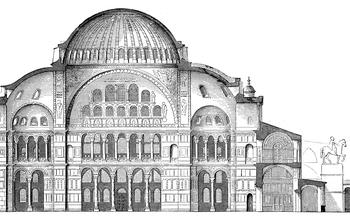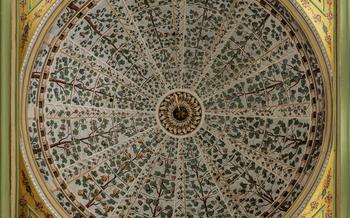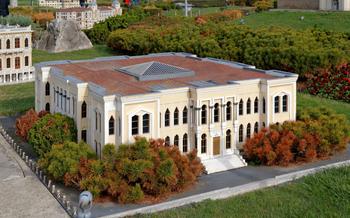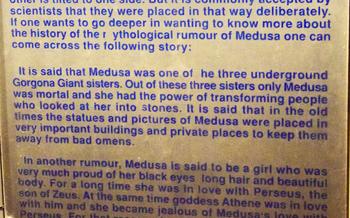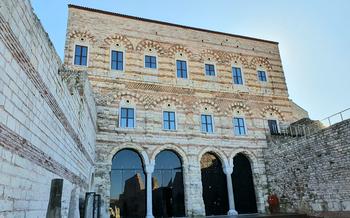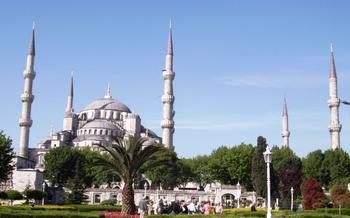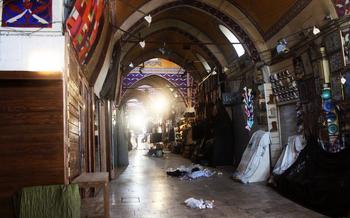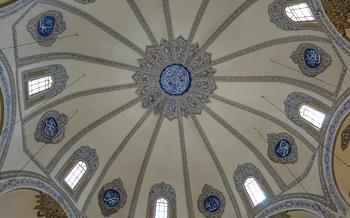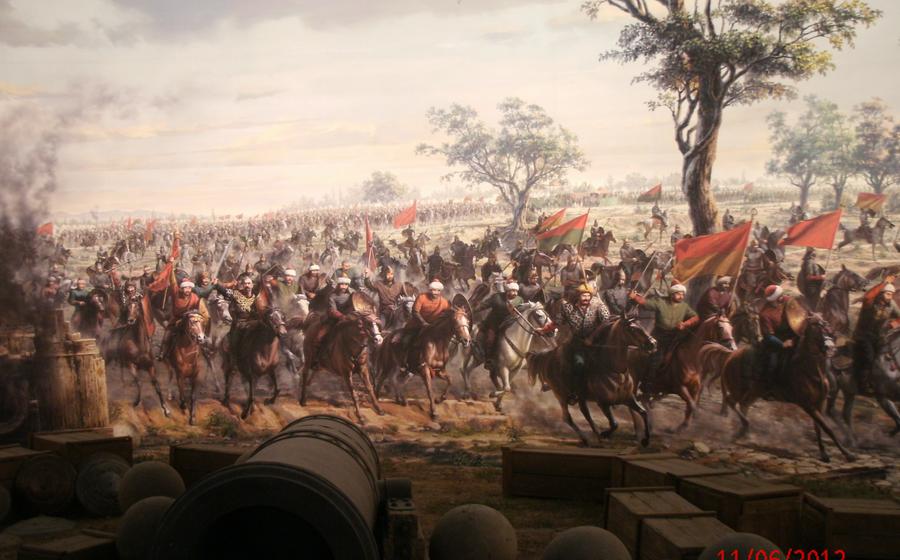
Panorama 1453 History Museum
- A Monument to the Siege of Constantinople:
- Immersive Experience Through Panoramic Art
- Engaging Audio-Visual Presentations
- Interactive Displays and Artifacts
- Virtual Reality Experience: Immerse Yourself in History
- Historical Significance of the Location
- Duration of the Visit and Recommended Time
- Cost of Admission and Ticketing Information
- Museum Hours and Operating Schedule
- Access and Transportation Options
- Amenities and Facilities at the Museum:
- Educational Programs and Workshops
- Nearby Attractions and Points of Interest:
- Insider Tip: Hidden Gem: The Museum of Turkish Calligraphy Arts
A Monument to the Siege of Constantinople:
The Panorama 1453 History Museum stands as a testament to the historic Siege of Constantinople in 1453, a pivotal event that marked the fall of the Byzantine Empire and the rise of the Ottoman Empire. Located within the Topkapi Palace grounds, the museum's strategic position mirrors the significance of the battle that took place just outside these very walls. Its architectural design, featuring a circular building with a domed roof, complements the immersive experience within, creating a symbolic representation of remembrance and honor for this defining moment in history.
Immersive Experience Through Panoramic Art
The Panorama 1453 Museum showcases a stunning panoramic artwork that transports visitors back in time to the heart of the epic Siege of Constantinople. Created by a team of talented artists, this colossal painting captures the essence of the battle with remarkable detail and realism. Spanning 360 degrees and measuring 23 meters in height, the artwork offers a breathtaking immersive experience, allowing visitors to witness the siege unfold from every angle.
The painting depicts the pivotal moments of the battle, from the initial Ottoman attacks to the final conquest of the city. The viewer is positioned as an observer on the ramparts of Constantinople, surrounded by the chaos and devastation of the siege. The meticulous attention to detail brings to life the clashing armies, the towering warships, and the cityscape of Constantinople in all its grandeur.
The panoramic artwork is not merely a historical record but an emotional journey that evokes a sense of awe and wonder in visitors. The vibrant colors, dramatic lighting, and realistic portrayal of the battle create a powerful sensory experience, leaving a lasting impression on the mind and heart.
Engaging Audio-Visual Presentations
The Panorama 1453 History Museum enhances the immersive experience with a captivating audio-visual presentation that brings the panoramic artwork to life. The synchronized sound effects and lighting create a multisensory environment, immersing visitors in the intensity of the battle. The audio commentary, available in multiple languages, provides a detailed narration that guides visitors through the events of the siege, offering historical insights and context. The audio guide is user-friendly and accessible, ensuring that visitors of all ages and backgrounds can fully engage with the museum's storytelling. Additionally, the museum caters to visitors with disabilities by providing accessible audio-visual presentations, ensuring an inclusive experience for all.
Interactive Displays and Artifacts
The Panorama 1453 History Museum brings history to life through interactive displays and authentic artifacts. Visitors can engage with touchscreens and multimedia presentations to explore various aspects of the siege, including military strategies, weaponry, and the daily lives of soldiers and civilians. Display cases showcase authentic artifacts from the era, such as armor, weapons, coins, and manuscripts, providing a tangible connection to the past. Thematic sections within the museum offer deeper insights into specific aspects of the event, such as the role of artillery, the construction of fortifications, and the impact of the siege on the city and its people. These interactive displays and artifacts not only enhance the visitor experience but also contribute to a deeper understanding of the historical significance of the Siege of Constantinople.
Virtual Reality Experience: Immerse Yourself in History
The Panorama 1453 History Museum offers a unique opportunity to enhance your visit with a captivating virtual reality (VR) experience. Using cutting-edge technology, the VR component allows you to step back in time and witness the epic battle from a completely immersive perspective.
Donning a VR headset, you'll be transported into the heart of the siege, surrounded by the sights, sounds, and emotions of that fateful day. Experience the thunderous roar of cannons, the clash of swords, and the desperate cries of soldiers as you navigate through the chaotic battlefield.
The VR experience is meticulously crafted to recreate the historical event with stunning realism, allowing you to feel as if you're truly part of the action. Engage in virtual combat, witness the strategies of both sides unfold, and gain a deeper understanding of the complexities of the siege.
The VR experience is available at an additional cost and typically lasts for around 15-20 minutes. It's an unforgettable add-on that complements the panoramic artwork and audio-visual presentations, providing a truly immersive and interactive journey into the past.
Historical Significance of the Location
The Panorama 1453 History Museum is situated within the grounds of the Topkapi Palace, a sprawling complex that served as the primary residence of the Ottoman sultans for over 400 years. The palace itself holds immense historical significance, as it was the center of the Ottoman Empire, where important decisions were made and ceremonies were held.
During the Siege of Constantinople, the Topkapi Palace grounds played a crucial role as the headquarters of the Ottoman army. Sultan Mehmed II, the conqueror of Constantinople, personally oversaw the siege operations from within the palace. The strategic location of the palace allowed the Ottomans to effectively command and coordinate their forces, contributing to their ultimate victory.
In addition to its strategic importance, the Topkapi Palace is home to several historical landmarks and monuments that offer visitors a glimpse into the grandeur and splendor of the Ottoman Empire. These include the Imperial Treasury, the Harem, and the Museum of Islamic Art, which house a vast collection of artifacts, jewelry, and manuscripts from the Ottoman era.
By visiting the Panorama 1453 History Museum within the Topkapi Palace complex, visitors can not only learn about the pivotal siege but also explore the rich history and cultural heritage of the Ottoman Empire, making for a comprehensive and immersive experience.
Duration of the Visit and Recommended Time
Exploring the Panorama 1453 History Museum typically takes around 1 to 2 hours, depending on your pace and level of interest. The panoramic artwork is the main attraction, but you can also spend additional time exploring the interactive displays, artifacts, and audio-visual presentations.
Recommended time slots:
-
To avoid crowds and ensure a comfortable experience, aim to visit the museum early in the morning or late in the afternoon. Weekdays tend to be less busy than weekends, especially during the peak tourist season.
-
If you're short on time, you can focus on the panoramic artwork and skip the other exhibits. However, it's worth allocating enough time to fully immerse yourself in the immersive experience and learn more about the historical context of the siege.
-
Plan your visit based on your interests and schedule. If you're particularly interested in the history of the siege or enjoy interactive exhibits, you may want to allocate more time to explore the museum in depth.
Cost of Admission and Ticketing Information
Exploring the captivating history of the Panorama 1453 History Museum comes with an admission fee. General admission tickets are priced reasonably, allowing visitors to delve into the immersive experience without breaking the bank. However, the museum also offers discounted rates for students, seniors, and families, ensuring that everyone has the opportunity to witness the grandeur of this historical masterpiece.
Payment options at the museum are flexible, catering to the convenience of visitors. Cash is accepted for those who prefer traditional methods, while credit cards offer a seamless and secure payment experience. For added convenience, online booking is available, allowing you to secure your tickets in advance and skip the queues, making the most of your valuable time in Istanbul.
Museum Hours and Operating Schedule
The Panorama 1453 History Museum adheres to regular operating hours to ensure that visitors can plan their visit accordingly. During weekdays, the museum typically opens its doors from 9:00 AM to 6:00 PM, providing ample time for exploration. On weekends, the museum extends its hours slightly, welcoming visitors from 9:00 AM to 7:00 PM, allowing for a more leisurely experience.
Seasonal variations may affect the museum's schedule, with occasional special hours or closures announced in advance. To avoid any inconvenience, it is highly recommended to check the museum's official website or contact them directly for the most up-to-date information. This ensures that visitors can plan their trip effectively and make the most of their visit.
The museum remains accessible during national holidays, except for a few designated closures, which are usually communicated well in advance. Special events or exhibitions may also influence the museum's operating hours, so checking the website or contacting the museum beforehand is always advisable.
Access and Transportation Options
The Panorama 1453 History Museum is conveniently located within the Topkapi Palace complex, making it easily accessible by various modes of transport. For those using public transportation, the museum is just a short walk from the Gülhane Tram Station, which offers direct connections to many parts of the city. Alternatively, visitors can take a scenic bus ride along the Bosphorus Strait and disembark at the Topkapi Palace stop. Taxis are also readily available and can drop you right at the entrance of the museum. For those arriving by car, there are designated parking facilities within the Topkapi Palace complex, ensuring a hassle-free visit. To enhance your exploration of the area, consider combining your visit to the Panorama 1453 Museum with other nearby attractions such as the Hagia Sophia, the Blue Mosque, or the Grand Bazaar, creating a memorable and enriching historical journey.
Amenities and Facilities at the Museum:
The Panorama 1453 History Museum offers a range of amenities to enhance the visitor experience:
-
Gift Shop: A well-stocked gift shop provides a variety of souvenirs, books, and historical artifacts related to the siege and Ottoman history.
-
Restrooms: Clean and well-maintained restrooms are available for the convenience of visitors.
-
Accessibility: The museum is fully accessible, with ramps, elevators, and designated seating for visitors with disabilities.
-
Multilingual Assistance: Multilingual assistance is available upon request, with staff members fluent in various languages to assist international visitors.
Educational Programs and Workshops
The Panorama 1453 History Museum offers a range of educational programs and workshops that delve deeper into the siege of Constantinople and Ottoman history. These programs provide a unique opportunity for students, researchers, and history enthusiasts to engage with experts, learn from their insights, and gain a comprehensive understanding of this pivotal event.
Workshops and lectures are organized on various topics related to the siege, including military tactics, cultural exchange, and the impact of the Ottoman conquest on the region. Renowned historians, archaeologists, and academics lead these sessions, sharing their knowledge and research findings with participants.
The museum also collaborates with educational institutions to design tailored programs for students of different levels. These programs can include guided tours, interactive activities, and hands-on experiences that bring history to life and foster a deeper appreciation for the past.
To participate in these educational programs, visitors can check the museum's website for upcoming events and registration details. The museum also offers customized programs for groups upon request, providing a unique and enriching learning experience for history enthusiasts of all ages.
Nearby Attractions and Points of Interest:
After immersing yourself in the history of the Siege of Constantinople at the Panorama 1453 History Museum, you can further explore Istanbul's rich cultural heritage by visiting nearby attractions. Just a short walk away lies Topkapi Palace, the opulent former residence of Ottoman sultans, boasting stunning architecture, intricate tiles, and a treasury filled with jewels and artifacts.
For a glimpse into Istanbul's Byzantine past, head to the Hagia Sophia, a magnificent sixth-century basilica that served as the cathedral of Constantinople. Marvel at its soaring dome, intricate mosaics, and the interplay of light and shadow within its grand interior.
To experience the vibrant atmosphere of a traditional Turkish bazaar, visit the Grand Bazaar, one of the oldest and largest covered markets in the world. Lose yourself in a labyrinth of colorful shops selling everything from carpets and spices to jewelry and ceramics, and enjoy the lively haggling that is an integral part of the bazaar experience.
Complete your exploration with a visit to the Blue Mosque, renowned for its six minarets and exquisite blue tiles that adorn its exterior. Step inside to admire the vast prayer hall, intricate calligraphy, and the serene atmosphere that envelops this sacred space.
By combining a visit to the Panorama 1453 History Museum with these nearby attractions, you'll gain a comprehensive understanding of Istanbul's rich history and diverse cultural heritage, making for an unforgettable and enriching travel experience.
Insider Tip: Hidden Gem: The Museum of Turkish Calligraphy Arts
Nestled in the heart of Istanbul's historic Sultanahmet district, just a short walk from the Panorama 1453 History Museum, lies a hidden gem that offers a unique glimpse into the rich world of Islamic calligraphy. The Museum of Turkish Calligraphy Arts, housed in a beautifully restored 18th-century Ottoman mansion, showcases a stunning collection of handwritten manuscripts, Qur'ans, and decorative calligraphy panels.
As you step inside the museum, you'll be transported back in time to the era of the Ottoman Empire, where calligraphy was revered as a sacred art form. The walls are adorned with exquisite examples of Islamic calligraphy, each stroke and swirl telling a story of devotion, creativity, and the enduring power of the written word.
One of the highlights of the museum is the "Hilye-i Serif," a beautifully illuminated scroll that depicts the Prophet Muhammad's physical appearance and noble qualities. This intricate work of art, created by the renowned calligrapher Seyyid Kasim Gubari in the 17th century, is a testament to the deep reverence and devotion held by Muslims for the Prophet.
Another must-see exhibit is the "Divan-i Hikmet," a collection of poems written by the Ottoman Sultan Abdulhamid II, who was not only a skilled calligrapher but also a prolific poet. His verses, inscribed in elegant calligraphy, offer a unique insight into the mind and heart of one of the last great Ottoman rulers.
Visiting the Museum of Turkish Calligraphy Arts is a wonderful opportunity to delve into the rich cultural heritage of Istanbul and to appreciate the artistry and devotion that went into the creation of these beautiful works of art. It's a hidden gem that should not be missed by anyone interested in Islamic art, history, or calligraphy.
